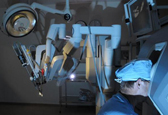
Robotic-Assisted Lung Biopsy
Precise, Minimally Invasive Lung Cancer Diagnosis
Most lung nodules aren't cancerous, but it's important to know for sure — all lung cancers begin as a lung nodule.
The Ion™ Endoluminal Robotic Bronchoscopy System allows doctors at El Camino Health to use a precise, minimally invasive procedure to take a tissue sample (biopsy) to look for cancer. Most lung nodules are in the outer lung area, which can be difficult to reach using traditional surgical methods.
The Ion system uses a thin, easily maneuverable catheter (a flexible tube) that can move 180 degrees in all directions. This lets doctors navigate through small, tightly curving airways to reach the nodule. They can take samples from different areas of the nodule, which helps assure an accurate diagnosis.
How Robotic-Assisted Bronchoscopy Works
Your doctor uses a low-dose CT scan to get a detailed, 3D picture of your lungs — this method uses 75 percent less radiation than a traditional CT scan to plan your procedure, using Ion's advanced software.
To perform the procedure:
- Your doctor controls the robotic attachment to guide a catheter into your mouth and reach the lung nodule.
- The catheter is locked into place, and a tiny, flexible needle is inserted through the catheter to the lung nodule to take samples from different areas of the nodule.
The higher precision and accuracy of this approach, compared with a conventional needle biopsy, help prevent the need for repeat biopsies for diagnosis. That means your doctor gets the information they need to confirm a diagnosis in a single procedure. If the nodule is cancerous, they can begin treatment right away.
The procedure only takes about an hour, and it doesn’t require any time in the hospital — it’s an outpatient procedure.

